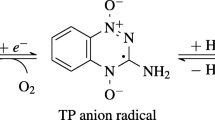Abstract
IT has been suggested that the hypoxic centres within a tumour mass are likely to be relatively resistant to sterilization by ionizing radiation1. Compounds which could be introduced into such hypoxic centres and which can mimic the radiation sensitizing effect of oxygen may therefore be of great value in the radiation therapy of cancer. A number of chemicals are known to sensitize mammalian cells to the effects of ionizing radiation2. One such compound is para-nitroacetophenone (PNAP), which was selected as a potential radiosensitizer because of its strong electron affinity3. Subsequent studies demonstrated that PNAP was a good selective hypoxic radiosensitizer in mammalian cells4,5. Recent studies with analogues of PNAP indicate that the nitro group is essential for radio-sensitizing activity in Chinese hamster cells, and furthermore that sensitizing ability improves with increasing electro-negativity (manuscript in preparation). Because 5-nitrofurans are known to be more electronegative than the corresponding nitrobenzene derivatives6, we tested two well documented nitrofuran derivatives for radiosensitizing activity.
Similar content being viewed by others
References
Gray, L. H., Brit. J. Radiol., 26, 638 (1953).
Bridges, B. A., in Advances in Radiation Biology (edit. by Augenstein, L. G., Mason, Ronald, and Zelle, Max.), 3, 123 (Academic Press, London and New York, 1969).
Adams, G. E., in Radiation Protection and Sensitization (edit. by Moroson, H. L., and Quintiliani, M.), 3 (Taylor and Francis, London, 1970).
Chapman, J. D., Webb, R. G., and Borsa, J., Intern. J. Radiat. Biol., 19, 561 (1971).
Adams, G. E., Asquith, J. C., Dewey, D. L., Foster, J. L., Michael, B. D., and Willson, R. L., Intern. J. Radiat. Biol., 19, 575 (1971).
Sasaki, T., Pharm. Bull., 2, 104 (1954).
McCalla, D. R., Reuvers, A. P., and Kaiser, Christel, J. Bact., 104, 1126 (1970).
McCalla, D. R., Reuvers, A. P., and Kaiser, Christel, Biochem. Pharmacol., 20, 3532 (1971).
McCalla, D. R., Reuvers, A. P., and Kaiser, Christel, Cancer Res., 31, 2184 (1971).
Adams, G. E., in Current Topics in Radiation Research (edit. by Ebert, Michael, and Howard, Alma), 3, 35 (North-Holland Publishing Company, Amsterdam, 1967).
Paul, H. E., and Paul, M. F., in Experimental Chemotherapy (edit. by Schnitzer, R. J., and Hawking, F.), 2, 307 (Academic Press, New York, 1964).
Author information
Authors and Affiliations
Rights and permissions
About this article
Cite this article
REUVERS, A., CHAPMAN, J. & BORSA, J. Potential Use of Nitrofurans in Radiotherapy. Nature 237, 402–403 (1972). https://doi.org/10.1038/237402a0
Received:
Issue Date:
DOI: https://doi.org/10.1038/237402a0
- Springer Nature Limited





